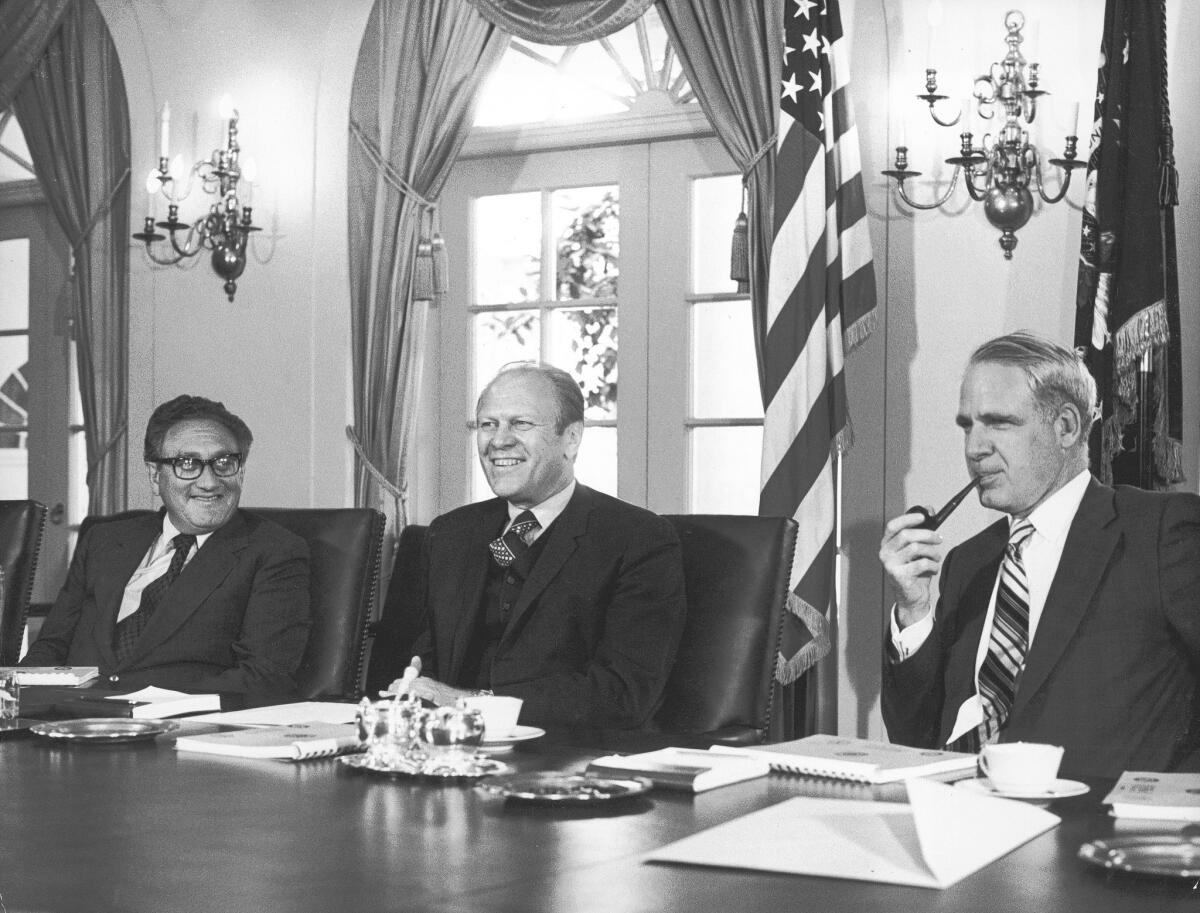James Schlesinger dies at 85; former Defense secretary and CIA chief

- Share via
James R. Schlesinger, the hawkish and sometimes overbearingly erudite conservative whose controversial Washington career included serving as U.S. secretary of Defense under Presidents Richard Nixon and Gerald Ford before becoming the nation’s first Energy chief in Jimmy Carter’s administration, died Thursday at a Baltimore hospital where he was being treated for pneumonia. He was 85.
His death was confirmed by his daughter, Ann Schlesinger.
A Harvard University-trained economist, Schlesinger built an impressive resume of government service, beginning with his appointment as assistant director of the Office of Management and Budget after Nixon’s presidential victory in 1968. In that post he began to mold a reputation for making unpopular decisions with his successful push to cut $6 billion from the defense budget.
Later, after assuming the top job at the Pentagon in 1973, he became a forceful advocate for boosting defense spending in the post-Vietnam War period. He also became known as a perceptive nuclear strategist who helped shift the Nixon administration’s thinking on nuclear weapons, advocating a flexible response of limited strikes to replace the deterrence policy of mutually assured destruction while maintaining the capability of U.S. conventional forces.
“James Schlesinger was the ideal hawk to exploit the new weaponry developed under a decade of mutually assured destruction,” Michio Kaku and Daniel Axelrod wrote in “To Win a Nuclear War” (1987). “Nixon grudgingly acknowledged the man’s command and grasp of nuclear strategy.”
Under Nixon, Schlesinger also served as chair of the Atomic Energy Commission and director of the Central Intelligence Agency, but in all his various roles his personality was frequently an issue. At an early meeting in the Oval Office, his typically blunt manner so alienated the president that Nixon said: “I don’t want to see that guy in my office again.”
He remained in Ford’s cabinet after Nixon’s resignation in 1974 but disagreements with the president and Secretary of State Henry Kissinger led to his ouster in the “Halloween massacre” of November 1975.
“His aloof, frequently arrogant manner put me off,” Ford said of Schlesinger in the biography “Kissinger” (1992) by Walter Isaacson. “I could never be sure he was leveling with me.”
During a more than two-year tenure as Defense secretary, Schlesinger confronted numerous crises. He oversaw the airlifting of supplies to Israel in the 1973 Yom Kippur War; U.S. policy on the 1974 Turkish invasion of Cyprus; the helicopter evacuation of the last Americans from Saigon as North Vietnamese troops overran the city in 1975; and the rescue of the crew aboard the U.S.-registered Mayaguez freighter captured by Cambodia’s Khmer Rouge, which led to the deaths of 41 U.S. military personnel.
He fell from favor for impeding the efforts of Ford and Kissinger to secure a strategic arms-control agreement with the Soviet Union and for his uncompromising dealings with Congress over the Pentagon budget. He was replaced by Donald Rumsfeld, who at age 43 was the youngest person to serve as Defense secretary.
Schlesinger, whom Kissinger once described as “my equal” intellectually, returned to government in 1976 after supporting Carter’s presidential bid. He served as the nation’s “energy czar” before heading the Energy Department created during the Carter administration.
Charged with coordinating several federal agencies under one umbrella during the oil crisis of the 1970s, when Arab nations embargoed the delivery of petroleum to the U.S. and other countries, he became a symbol of Carter’s failed energy policy as gas lines grew and prices soared. In 1979 Schlesinger was forced out in a cabinet reorganization.
James Rodney Schlesinger was born on Feb. 15, 1929, in New York to Julius and Rhea Schlesinger. Although raised in a Jewish family, he converted to the Lutheran faith while a student at Harvard, where he earned a bachelor’s degree in 1950, a master’s in 1952 and a doctorate in 1956.
Schlesinger taught economics at the University of Virginia in Charlottesville, Va., for eight years until 1963. He then moved to the Rand Corp. and was director of strategic studies there until 1969, when he joined the Nixon administration.
At the CIA, he was angered to learn the spy agency had lent support to ex-agents E. Howard Hunt and James McCord, who were convicted of burglary in the Watergate break-in. He ordered disclosure of all violations of the CIA charter barring domestic operations, resulting in nearly 700 pages of memos about spying on Americans.
In his earlier stint at the Atomic Energy Commission, he brought his wife and two of his daughters to Amchitka Island in the Aleutians to observe a 1971 nuclear-bomb test and prove to critics that it could be conducted without harm to people or the environment.
An avid bird-watcher, he considered himself an environmentalist, although he had many critics with a sharply different view of him. At a Washington rally against his advocacy of nuclear power after the Three Mile Island disaster in 1979, activist Jane Fonda told the crowd: “Putting Schlesinger in charge of nuclear power is like putting Dracula in charge of a blood bank.” Schlesinger later countered that she and the other protesters were “the same people who were for Ho Chi Minh.”
His wife, the former Rachel Mellinger, died in 1995. He is survived by eight children and 11 grandchildren.
More to Read
Start your day right
Sign up for Essential California for the L.A. Times biggest news, features and recommendations in your inbox six days a week.
You may occasionally receive promotional content from the Los Angeles Times.






